Part 2: The Essentials of the System
PART B. The Essentials of the System
SECTION B.1., Foam Concrete (FC)
B.1.1 General Description
Foam Concrete is a mixture of silicate sand, Portland Cement, foam and (potable) water.
FC can be produced in several densities, each with its own composition and properties. Typical densities for walls in low cost housing are 1200, 1400, 1600 and even 1800kg/m3.
In general, a higher density has a higher compressive strength value, but lower thermal insulation.
B.1.2 Sand
Sand for FC must be of a high (90%) silica content. It should have a minimum of 15% fines (small particles of no more than 0.075mm) and maximum grain size not over 2mm for foam concrete of a density of 1,200 kg/m3 up to 6mm for a density of 1,600kg/m3.
A sieve test should be conducted to ascertain its suitability for the production of FC. Sand should be free of pollution, river sand is preferred. Sea sand is only suitable if washed thoroughly to remove chloride etc. Larger stones must be removed before mixing.
B.1.3 Cement
Cement for the production of FC must be Portland cement of at least 32.5MPa.
Fly-ash can replace part of the cement.
B.1.4 Foaming Agents
There are a few types of foaming agents available. The most common types are made of hydrolysed animal protein or are synthetic. These foaming agents are diluted in water and foam is formed by means of a foam generator.
B.1.5 Production of Foam
Foaming agent is provided by a number of companies. The protein based or synthetic foaming agent is diluted in potable water and then pumped through a foam generator to produce a stable foam. The foam generator is fitted with a hose to pump the foam into the mixer. The quantity of produced foam can be measured as it is essential to have the correct quantity added to the sand-cement slurry.
 Stable foam produced with foam generator.
Stable foam produced with foam generator.
B.1.6 Water
Water must be potable water, if possible not more than 25°C. With higher temperature the setting of the cement speeds up, leaving less time for transport and casting.
B.1.7 Admixtures
There are generally speaking three kind of admixtures for concrete: water reducers, retarders and accelerators. They may be used in combination with foam, but only after seeking expert advice from supplier or concrete expert.
B.1.8 Properties of CLC

Fire rating
Foam concrete has a very good resistance to fire, thanks to the air-bubbles in the concrete. Higher air content leads to higher fire rating. Fire resistance of FC far exceeds that of dense concrete.
Shrinkage
All cement products are subject to shrinkage. Foam concrete is in fact a cement-rich mortar and is subject to shrinkage as well. With proper production methods the shrinkage is limited to 0.1mm per m1 wall. When foam concrete is not sufficiently mixed, the shrinkage might incidentally be higher. Insufficient mixing results in a non-homogeneous foam concrete that can lead to shrinkage cracks. It is vital to seek the advice of supplier of foaming agent or foam concrete expert prior to construction to work out the best mix composition and working procedures.
Water absorption
Water absorption of foam concrete is low thanks to the closed cellular structure. Supplier of foaming agent can supply test reports on this subject.
B.1.9 Equipment for the Production of Foam Concrete
Worldwide there are a number of companies that supply equipment that is necessary for the production of foam concrete. The required equipment consists of
- Foam generator – For the production of foam.
- Mixer unit – For mixing of the cellular concrete.
- Pumping unit – To pump the cellular concrete into the moulds.
The above equipment can be supplied as separate units, or as a complete plant that incorporates all functions.
B.1.10 The mixing
Mechanical mixers come in a wide variety and capacities. They range from very small capacity (a few hundred litres) to truck mixers with a capacity of several cubic meters. In general it can be said that larger mixers provide a more consistent quality of cellular concrete.
The sand, the cement and water must be mixed first to a homogeneous mixture before the foaming agent (and pp fibres) are put in. The mixing time depends, but the foam must be completely taken up into the mixture.
It is often possible to order the sand-cement-water mix from a concrete batching plant and then mix in the foam and fibres on site.
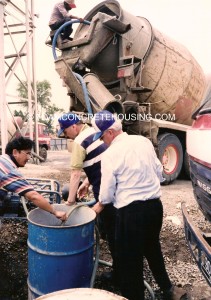 Foam is produced and directly pumped into a mixer truck
Foam is produced and directly pumped into a mixer truck
B.1.11 Steel Reinforcement Bars
Reinforcement bars (re-bars) are placed in the wall according to engineer’s design and as required by local Building Codes and Regulations.
Typically, mild steel reinforcement bars of 6mm are used in a 400mm x 400mm grid for all the walls and additional bars at positions subject to high stress loads.
In earthquake prone areas reinforcement columns may be required at the junctions and corners of all walls and connected with a beam structure along the top of the walls. Reinforcement bars are also needed to strengthen the edges of wall openings such as windows and doorframes
PVC spacers are used to ensure sufficient concrete cover.
Starter bars are placed in the foundation to anchor the walls to the floor / beams.
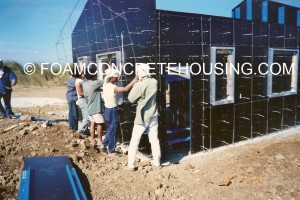 Prefabricated rebar netting is placed in the mould.
Prefabricated rebar netting is placed in the mould.
B.1.12 Polypropylene Fibres
Polypropylene monofilament or fibrillated fibres are often added to FC. It is recommended that polypropylene fibres are added to the mix to combat shrinkage, to prevent bleeding and to enhance the mechanical properties of the mixture.
On average one bag of 0.9kg is added per m3 cellular concrete.
SECTION B.2., Equipment
B.2.1 Formwork
Thanks to the millions of air bubbles, FC is liquid before setting. This liquidity requires a very good and tight formwork mould. FC is very gentle on the mould as it does not require vibrating, which, in particular with thin walls, would be very damaging to the mould.
During casting, FC is liquid and will fill every cavity in the mould, no air pockets will form under window openings, but FC will pour out of every opening in the formwork.
Formwork must be able to be erected and stripped very fast to allow a cycle of one day, as this is the most cost effective. Weight of formwork panels is a consideration when the panels have to be moved by hand as is often the case.
System formwork comes in panels that are built up in two components: the frame of the panel and the skin. The frame is designed to withstand the pressure of the concrete. The skin is the surface that holds the concrete in place and forms the concrete surface.
Formwork comes in many versions and combinations of structure and skin.
There are four main types of suitable formwork available in the market:
B.2.1.1 One material formwork systems
These are formwork systems where frame and skin are made of the same materials. Systems of this type are made of plastic, aluminium or steel.
Aluminium skin is not suitable for foam concrete as it does not provide a nice surface finish for foam concrete. Plastic is not very strong and has limited use.
Several companies can supply these types of formwork, both in standard panels as well as custom made. Plastic panels are small and require many tie-bars. Steel formwork comes and small or even storey-high panels. Aluminium is mostly available in storey-high panels and is as available as standard or custom made system.
B.2.1.2 Small panel modular formwork
Panels are of limited size but can be tied together to form larger panels. Maximum size is often 1,00m x 1.50m (wxh).
Panels are made from separate materials for frame and panel: frame is almost always from steel with plywood panel. Its limited size and weight make them suitable for manual handling.
These systems are readily available.
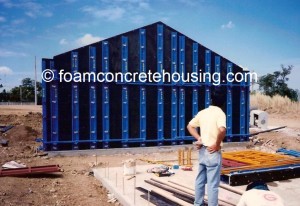 Formwork steel structure with plywood surface
Formwork steel structure with plywood surface
B.2.1.3 Wall high panel systems
Wall panels are normally 2.70m high, in some cases this is 2.64m.
The panels came in a range of widths, from 20cm to 90cm.
Frame is made from steel or from aluminium, plywood is most commonly used for the skin, also a plastic composite panel is available.
Aluminium frames are used to reduce the weight of the panels and facilitate handling.
These types of system formwork are very suitable for house construction as they can be handled manually, are labour efficient and give a nice finish to the foam concrete walls.
 Full aluminium formwork for 2-storey house design
Full aluminium formwork for 2-storey house design
General remarks on formwork
Depending on the quality, weight and system of the formwork, the handling and the maintenance, one set of formwork can be used to build from 50 to about 1.000 or even more houses.
It is advisable to treat all mould surfaces that come in contact with the concrete with a release agent to allow easy stripping and to protect the formwork. The use of a release agent also enhances the concrete surface.
It is advisable to purchase a formwork package from a reputable and experienced supplier to ensure constant quality of the panels and continued service back-up and guaranteed supply of spare parts and panels for subsequent projects.
Any formwork order should include sufficient spare parts. The supplier can propose on the total package.
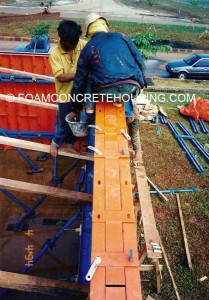 Top of gable wall is closed (full steel formwork)
Top of gable wall is closed (full steel formwork)
B.2.2 Foam Generators
A foam generator is required when foam made of a protein based or synthetic foaming agent is used. The foaming agent is diluted in water and the mixture is run through the foam generator that turns the aqueous mix into a stable foam.
Most foam generators require 380V power supply of 50 – 60 cycles.
They are fitted with a short suction hose and a longer hose to deliver the foam into the mixer. A timer or flow meter is used to gauge the volume of the foam.
B.2.3 Concrete Mixers
A great variety of mixers is available in the market and suitable for the mixing of the FC ingredients sand, cement, water and foam. Often polypropylene fibres are added to the mix. Also other admixtures may be added.
All type of mixers can be used, but more efficient mixers that are designed for foam concrete would bea better choice.
The larger the capacity of the mixer, the more constant the composition and quality of the FC. The most suitable to mix FC are mixer trucks. They have large capacity of several m3 and can deliver close to the moulds. They bring the sand-cement-water mix to the site where the foam is added and if required the pp fibres.
Smaller mixers can be placed stationary on the site, whereby the FC has to be transported over the site to the housing moulds. Smaller mixers can be placed near clusters of houses to minimize transport.
B.2.4 Horizontal Transport of Foam Concrete.
The foam concrete has to be delivered to the location of the moulds. If the foam concrete is mixed centrally, a mixer truck is the ideal means of transport. Also tanks on wheels or small trucks fitted with a flat container can be used. A special way of transport is a tractor with pressure vessels on wheels with a hose attached. The vessels can be pressurised with a compressor to push out the foam concrete via the hose directly into the moulds.
B.2.5 Concrete Pumps
A large range of pumps are available in the market. The range from small, screw type pumps to high capacity concrete pumps in use on large construction projects. For low cost housing, special mortar pumps are available.
B.2.6 Cranes
Casting may be done with a crane for vertical transport. The FC is discharged from mixer truck into a silo attached to the crane and hoisted above the moulds.
Often casting is done manually. The FC is discharged in flat silo ‘s directly next to the formwork mould. Buckets are filled with FC, hoisted and cast into the walls.
B.2.7 Scaffolding
All the walls must be reachable at the top during casting. This requires a scaffold along all walls. This facilitates the inspection of the walls prior to casting and allows the walls to be cast gradually all around. It is strongly advised to fill the mould of all walls gradually. Do not fill one wall completely before starting the casting of other walls. Some formwork supplier produce scaffolding as part of the formwork system. Separate scaffolding can be used as well.
B.2.8 Power Supply
Most foam generators, mixers and pumps work with a 3-phase power supply of 380V, 50 – 60 cycles. It is advisable to check on the exact requirements and investigate whether this power supply can be made available. It is advisable to get a generator-set to site as back-up or as main power supply. No power means no production, so a proper and stable power supply is essential.
Some available equipment with low capacity is suitable for 220V power supply.
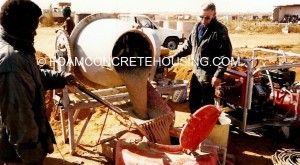


 D5 Creation
D5 Creation